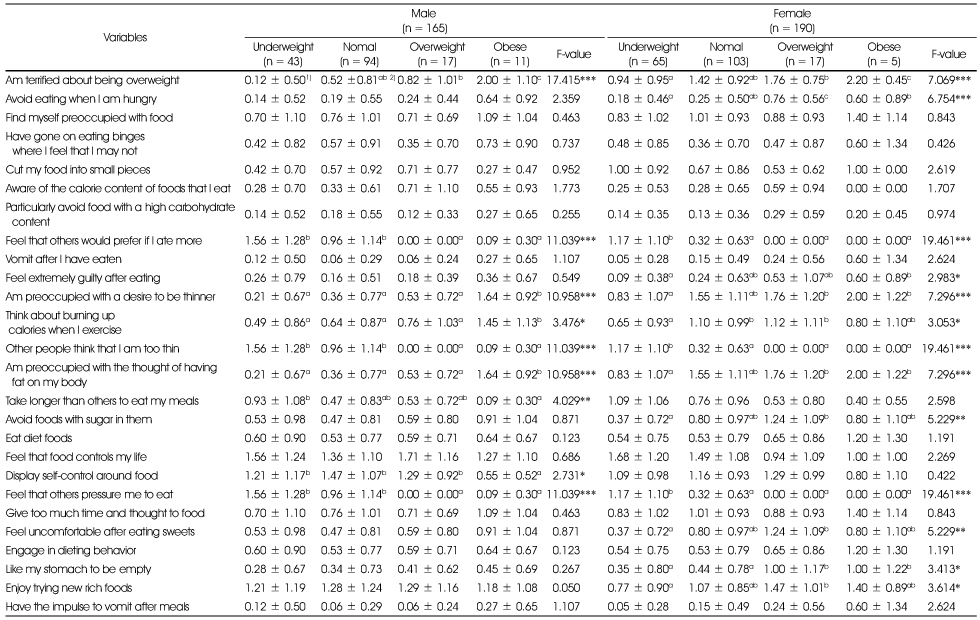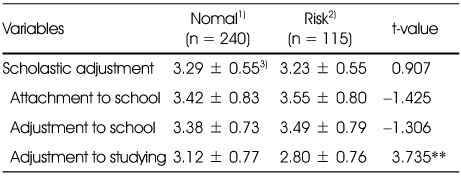Articles
- Page Path
- HOME > Korean J Community Nutr > Volume 17(6); 2012 > Article
-
Original Article
- A Study on the Correlation between Middle School Students' Eating Disorder Behavior and Scholastic Adjustment
- Joo-Yeon Yoo, Yang-Ho Jin, Se-Jeong Bae
-
Korean Journal of Community Nutrition 2012;17(6):707-713.
DOI: https://doi.org/10.5720/kjcn.2012.17.6.707
Published online: December 31, 2012
Department of Foodservice & Culinary Management, Graduate School of Kyonggi University, Seoul, Korea.
- Corresponding author: Se-Jeong Bae, Deptartment of Foodservice & Culinary Management, Graduate School of Kyonggi University, 71, Chungjeong-Ro 2-Ga, Seodemun-Gu, Seoul 120-702, Korea. Tel: (02) 390-5242, Fax: (02) 313-4131, baesejeong@hanmail.net
Copyright © 2012 The Korean Society of Community Nutrition
- 1,225 Views
- 2 Download
- 4 Crossref
Figure & Data
REFERENCES
Citations

- The big five personality traits and eating habits among female students at Zayed University
Sharifa AlBlooshi, Kawther AlSabbah, Shatha Thani, Rafiq Hijazi, Ayesha S. Al Dhaheri, Falak Zeb, Leila Cheikh Ismail
Frontiers in Public Health.2025;[Epub] CrossRef - Factors related to adolescent obesity and changes: a cross-sectional study based on the Korea Youth Risk Behavior Survey
Bora Lee, Ho Kyung Ryu
Korean Journal of Community Nutrition.2023; 28(5): 363. CrossRef - Analysis of Factors Influencing the Obesity of Adolescents in South Korea
Myung-Hee Jung, Jee-Seon Yi, Hye-Sun Jung
Journal of the Korean Society of School Health.2016; 29(1): 11. CrossRef - Gender differences in factors influencing the school adjustment by BMI
Ji Yeong Seo
Journal of the Korean Data and Information Science Society.2015; 26(2): 429. CrossRef
Anthropometric measurements and eating disorder behavior of subjects
1) Mean ± SD, 2) Not Significant, 3) N (%), 4) Nomal of eating disorder behavior: EAT-26 score < 20
5) Risk of eating disorder behavior: EAT-26 score ≧ 20
scholastic adjustment by gender
1) Mean ± SD
Eating disorder behavior and scholastic adjustment by weight group
1) Mean ± SD
2) Values with different alphabets with in each row are significantly different at α = 0.05 by Duncan's multiple range test
*: p < 0.05, **: p < 0.01
Eating disorder behavior by weight group
1) Mean ± SD
2) Values with different alphabets with in each row are significantly different at α = 0.05 by Duncan's multiple range test
*: p < 0.05, **: p < 0.01, ***: p < 0.001
Scholastic adjustment by eating disorder behavior group
1) Nomal of eating disorder behavior: EAT-26 score < 20
2) Risk of eating disorder behavior: EAT-26 score ≧ 20
3) Mean ± SD
**: p < 0.01
Correlation analysis
*: p < 0.05, **: p < 0.01
1) Mean ± SD, 2) Not Significant, 3) N (%), 4) Nomal of eating disorder behavior: EAT-26 score < 20 5) Risk of eating disorder behavior: EAT-26 score ≧ 20
1) Mean ± SD
1) Mean ± SD 2) Values with different alphabets with in each row are significantly different at α = 0.05 by Duncan's multiple range test *: p < 0.05, **: p < 0.01
1) Mean ± SD 2) Values with different alphabets with in each row are significantly different at α = 0.05 by Duncan's multiple range test *: p < 0.05, **: p < 0.01, ***: p < 0.001
1) Nomal of eating disorder behavior: EAT-26 score < 20 2) Risk of eating disorder behavior: EAT-26 score ≧ 20 3) Mean ± SD **: p < 0.01
*: p < 0.05, **: p < 0.01

 KSCN
KSCN






 Cite
Cite


